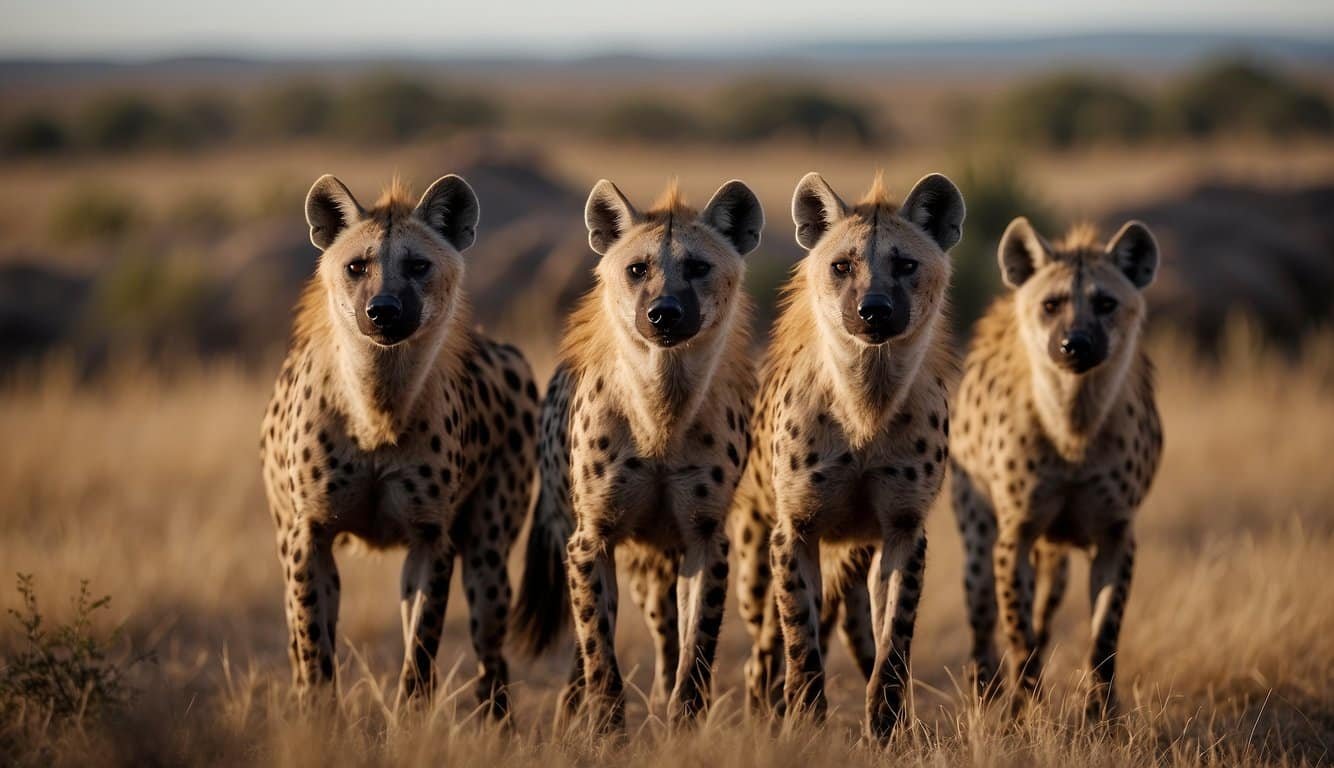Physical Characteristics of Hyenas

Hyenas are often recognized for their unique vocalizations and behaviors, but their physical characteristics are equally intriguing and diverse across different species.
Distinctive Features
Spotted hyenas, known for their laughter-like calls, have a robust set of teeth and powerful jaws capable of cracking bone. These adaptations are essential for their scavenger lifestyle, allowing them to extract maximum nutrients from carcasses. Striped and brown hyenas, although less powerful, also possess strong teeth suited to their diet.
Size and Build
Hyenas vary in size depending on the species. Spotted hyenas are the largest, with females often being the bigger sex, a unique trait among mammals. In comparison, the striped hyenas and brown hyenas are slightly smaller but share a similarly sturdy build adapted for survival in harsh environments. The aardwolf is notably smaller and has a more specialized diet of termites and insects.
Color Variations
Hyena fur color patterns are distinctive among the species, serving as camouflage and social signals. Spotted hyenas have fur with spots, as their name suggests, while striped hyenas feature vertical stripes on a lighter background. Brown hyenas are aptly named for their shaggy brown to grayish fur, and the aardwolf showcases a pale fur with dark stripes. These color variations help them blend into the landscape and communicate within their social structures.
Behavior and Social Structure

The spotted hyena is renowned for its complex social behaviors and dynamic clan hierarchy. Here we’ll explore how these animals interact, coordinate hunting efforts, and communicate within their intricate societies.
Social Hierarchy
Spotted hyenas live in large, matriarchal societies known as clans, which can consist of up to 80 individuals. Each clan has a strict social order, where females are generally dominant over males and the highest-ranking female, the matriarch, reigns over all. Cubs inherit their mother’s status, which determines their access to resources. This rank-dependent social inheritance greatly influences the social network structure within the clan.
Hunting and Feeding Habits
Contrary to popular belief, spotted hyenas are skilled hunters, not just scavengers. They hunt in groups using coordinated strategies to take down large prey, though they will not hesitate to scavenge carcasses or steal from other predators when the opportunity arises. Their diet is varied and includes a range of animals, reflecting their opportunistic nature.
Communication and Vocalizations
Spotted hyenas are also known for their wide range of vocalizations, which serve as important communication tools within the dense social network of the clan. Their laughs and groans can indicate age, identity, and social status. The ‘whoop’ sound, a signature call, can be heard over several kilometers and helps clan members communicate over long distances, especially during nocturnal activities.
Habitat and Distribution

Hyenas are fascinating creatures with a wide-ranging habitat that reflects their adaptability. From the grassy savannas of Africa to the arid deserts, and through territories in the Middle East to the forests of Asia, these animals have carved out a niche in a variety of ecosystems.
Geographical Range
Hyenas are most commonly associated with Africa, where the largest populations reside. In Africa, their footprint extends across the continent but is most concentrated in sub-Saharan regions, including the savannas, arid lands, and even semi-desert areas. Southern Africa is known to host significant numbers of brown hyenas, especially in semi-arid landscapes where their habitat selection varies among sites. In the forests and woodlands, the presence of hyenas is less prevalent, but they do adapt to these environments where available.
Hyenas also span a considerable range beyond the African continent. Populations can be found in parts of the Middle East and India, testament to their adaptability to different climates and territories. This wide distribution hints at the hyena’s historical success in diverse habitats.
Adaptations to Environment
Hyenas are not just limited by geography; they show a remarkable capacity for environmental adaptations. For instance, they have managed to thrive in areas where human activity has increased, as seen in Nepal, where their habitat preferences are studied to understand how they coexist in human-dominated landscapes. In Turkey’s Eastern Mediterranean region, GIS and remote sensing technology have illuminated that the striped hyenas in the area favor land with elevations around 400 meters, typically open maquis and agricultural lands.
Their physical traits and behavioral adaptations also play a role in their survival. Hyenas are known for their strong jaws and digestive systems capable of processing bones, allowing them to extract the utmost nutrition from their prey, which is implicitly valuable in resource-scarce environments like deserts. Their complex social structures help them defend territory and hunt effectively, whether in the open savannas or the dense woodlands of Asia.

